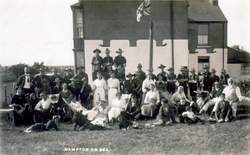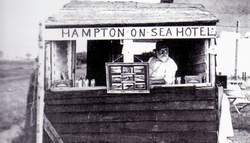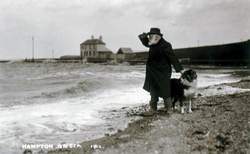Abandoned Communities ..... Hampton-on-Sea
Over the following years storms battered the houses closest to the sea, flooding occurred in spite of efforts to create sea defences, and the shoreline steadily retreated. Towards the end of 1898 the pier was partially removed in a vain attempt to reduce the erosion. In January 1899 a wall of faggots was built to protect 1 Hernecliff Gardens, the house at the seaward end of the terrace, and soon afterwards four 250 feet groynes were installed. However, the house was undermined by the sea in July that year. 1 and 2 Hernecliff Gardens were then abandoned by their owners, John Davis and W H Banks.
The census taken in 1901, when the “hamlet” of Hampton came under the Blean Rural District Council, gives a snapshot of the houses that were still inhabited and of the people living in them. 1 to 6 Hernecliff Gardens were uninhabited, and on the line for number 1 the census official added the comment “Part in Sea”. 7 to 12, however, were all inhabited. In Eddington Gardens 2 and 4 were inhabited, but not 1 and 3. In addition there were families living in Pleasant Cottage and two out of the three houses at Westbrook Cottages.
It is clear that Hampton-on-Sea was a community where residents gradually departed over a period of several years. Some may have left because their houses were under immediate threat, others such as the occupants of the two uninhabited houses in Eddington Gardens may have decided to move before things became so serious.
The population of Hampton, as recorded in the 1901 census, was 42, a total comprising 27 males and 15 females. 11 of these were children under the age of 18, including 8 boys and 3 girls. Those children between the ages of 5 and 13 are all described as scholars, but no form of education or occupation is given for Louisa Williams, aged 17, who was living at 10 Hernecliff Gardens.
No occupation is stated for any of the women at Hampton, with the exception of Florence Lissenden, aged 32, who was described as a general domestic servant. Together with her husband Horrace Lissenden and her two sons she was living with her parents, George and Esther Mount, at 4 Hernecliff Gardens.
George Mount was listed as a carting contractor and an employer. Horrace Lissenden was a carter working for him. Among the other men were two self employed fishermen, Thomas Horne, aged 74 at 9 Hernecliff Gardens, and Edward Horne, aged 36 and living next door at number 8. All the other working men were employees, with occupations such as agricultural labourer and brickmaker's labourer. Some of them may have been employed by the Land Company to work on the estate. We can imagine, for example, that the skills of William Mount, a general road labourer at 10 Hernecliff Gardens aged 61, of his son Jessie a plumber journeyman aged 20 at the same address, and of Thomas Ruck a building estate labourer aged 68 living at 7 Hernecliff Gardens, would have been useful if the estate had continued to develop in the way planned by the Land Company.
One head of household, John Willett, aged 71, who lived at 2 Eddington Gardens with his wife Sarah, was retired. Previously he had worked as a print compositor.
Early in the 1900s a concrete sea wall was built in an arc a short distance north west of Hernecliff Gardens, but during a storm in 1905 it was broken and the soil was scoured away behind it. The foundations of part of the wall can still be seen at low tide today, each end indicated by an upright marker. In 1903-04 the Herne Bay District Council consolidated the first 350 feet of the pier with a concrete casing, leaving the rest of the pier to continue to collapse. Again, the derelict lower part of the outer section of the pier can be seen today, curving slightly towards the west.
By this time not many people would have been inclined to move into Hampton-on-Sea. In 1903, however, a new resident at 4 Eddington Gardens was Edmund Reid. Reid, born in 1846, had led a colourful life that included a high level of competence in acting, singing, and conjuring, and in 1876 the distinction of being the first man in England to use a parachute. After joining the Metropolitan Police in 1872 he became Head of CID in the Whitechapel division in 1887. In that capacity he led the initial investigations into the series of murders attributed to “Jack the Ripper”.
4 Eddington Gardens was at the end of the terrace nearest to the sea. After Edmund Reid moved in it was re-named Reid's Ranch, and battlements and several cannons were painted on the external wall facing the sea. From a shed in his garden, called by Reid the Hampton-on-Sea Hotel, he would sell lemonade and postcards illustrating the disappearance of Hampton. Reid himself appeared on a high proportion of the postcards. He would write letters to the local press complaining about the council, having a particular bee in his bonnet about the state of the West Brook, or as he preferred to call it Lavender Brook.
In the end Edmund Reid moved away from Hampton in 1916. Living in Herne Bay he married Lydia Halling in May 1917, but he died on 5 December that year.
The census taken in 1901, when the “hamlet” of Hampton came under the Blean Rural District Council, gives a snapshot of the houses that were still inhabited and of the people living in them. 1 to 6 Hernecliff Gardens were uninhabited, and on the line for number 1 the census official added the comment “Part in Sea”. 7 to 12, however, were all inhabited. In Eddington Gardens 2 and 4 were inhabited, but not 1 and 3. In addition there were families living in Pleasant Cottage and two out of the three houses at Westbrook Cottages.
It is clear that Hampton-
The population of Hampton, as recorded in the 1901 census, was 42, a total comprising 27 males and 15 females. 11 of these were children under the age of 18, including 8 boys and 3 girls. Those children between the ages of 5 and 13 are all described as scholars, but no form of education or occupation is given for Louisa Williams, aged 17, who was living at 10 Hernecliff Gardens.
No occupation is stated for any of the women at Hampton, with the exception of Florence Lissenden, aged 32, who was described as a general domestic servant. Together with her husband Horrace Lissenden and her two sons she was living with her parents, George and Esther Mount, at 4 Hernecliff Gardens.
George Mount was listed as a carting contractor and an employer. Horrace Lissenden was a carter working for him. Among the other men were two self employed fishermen, Thomas Horne, aged 74 at 9 Hernecliff Gardens, and Edward Horne, aged 36 and living next door at number 8. All the other working men were employees, with occupations such as agricultural labourer and brickmaker's labourer. Some of them may have been employed by the Land Company to work on the estate. We can imagine, for example, that the skills of William Mount, a general road labourer at 10 Hernecliff Gardens aged 61, of his son Jessie a plumber journeyman aged 20 at the same address, and of Thomas Ruck a building estate labourer aged 68 living at 7 Hernecliff Gardens, would have been useful if the estate had continued to develop in the way planned by the Land Company.
One head of household, John Willett, aged 71, who lived at 2 Eddington Gardens with his wife Sarah, was retired. Previously he had worked as a print compositor.
Early in the 1900s a concrete sea wall was built in an arc a short distance north west of Hernecliff Gardens, but during a storm in 1905 it was broken and the soil was scoured away behind it. The foundations of part of the wall can still be seen at low tide today, each end indicated by an upright marker. In 1903-
By this time not many people would have been inclined to move into Hampton-
4 Eddington Gardens was at the end of the terrace nearest to the sea. After Edmund Reid moved in it was re-
In the end Edmund Reid moved away from Hampton in 1916. Living in Herne Bay he married Lydia Halling in May 1917, but he died on 5 December that year.
Four
A gathering of scouts, Edmund Reid and others outside his house at 4 Eddington Gardens
Postcards and lemonade for sale
Edmund Reid gazing out to sea at the point where the houses in Hernecliff Gardens used to stand.
The images on this page have been supplied by Martin Easdown, from the Marlinova Collection.


